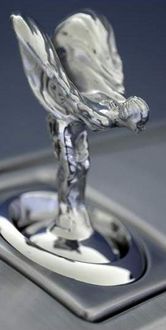.
Rolls-Royce Camargue
The Rolls-Royce Camargue, considered by many automotive enthusiasts to be the most distinctive Rolls-Royce vehicle ever produced, is a two-door coupé that was introduced in March of 1975. The Camargue's body, built in London by Rolls-Royce's coachbuilding division Mulliner Park Ward, was designed by Italian automotive designer Sergio Pininfarina — the Camargue was Rolls-Royce's first post-war production model not to be designed in-house.
When it was launched, the Camargue, which was the flagship of the Rolls-Royce lineup, was the most expensive production car in the world, selling for approximately US$147,000, or £83,000 (which adjusted for inflation, would be US$550,604 in 2005 dollars). The car was sold in very limited numbers in European, American, Canadian, Australian and Asian markets. It was named after a renowned breed of horses from the southern French province of Camargue.
The Camargue shares a platform with the Rolls-Royce Corniche and Silver Shadow. It is powered by the same 6.75 L V8 engine as the Silver Shadow, though the Camargue is slightly more powerful. The transmission was also carried over — a General Motors Turbo-Hydramatic 3-speed automatic.
The car, which is large for a coupé, sits on a 3048 mm (120 in) wheelbase. It was the first Rolls-Royce automobile to be designed to metric dimensions, and was the first Rolls-Royce to feature a slanted grille; the Camargue's grille slants at an inclined angle of seven degrees. It was also the first vehicle in the world to offer completely automatic split-level climate control, a system that reputedly required 8 years to develop.
The Camargue's design is unlike that of any Rolls-Royce before or since. The car's lines are angular and sleek, typical of an Italian luxury sedan. The car's body is long and wide, but unmistakably that of a coupé. The wideness of the body is further emphasized by a wide grille, headlights and tail lights.
The first 60 Camargues produced used SU carburettors, while the remaining 471 used Solex units. The Camargue was fitted with the Silver Shadow II's power rack and pinion steering rack in February 1977. In 1979, it received the rear independent suspension of the Silver Spirit.
Production of the Rolls-Royce Camargue ended in 1986. During the car's 11-year production run, 530 Rolls-Royce Camargues were built, as well as one specially-ordered Bentley Camargue.
Gallery
External links

| ||
| ROLLS-ROYCE | ||
|
BMW | Rolls-Royce | Mini Current Models: Phantom (VII) · Drophead · Phantom Coupe · Ghost Historic Models: Silver Seraph · Silver Spur / Flying Spur · Silver Spirit · Silver Shadow · Silver Cloud · Silver Wraith · Silver Dawn · Silver Ghost · 10 HP · 15 HP · 20 HP · 20/25 · 30 HP · 25/30 Wraith · Camargue · Corniche · Phantom I · Phantom II · Phantom III · Phantom IV · Phantom V · Phantom VI · Armoured Car · Legalimit Concept Cars: 1EX · 100EX · 101EX · 200EX Concept Specials: FAB 1 · Cloudesque · Silver Ghost Boat Tail Speedster · Silver Spur Hooper Landaulette · Phantom II Star of India | ||
| Sir Henry Royce and Charles Rolls | Corporate website | A brand of BMW AG |

